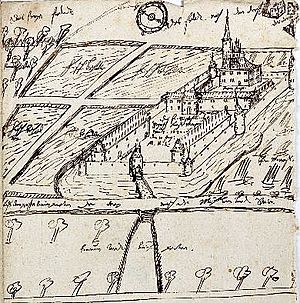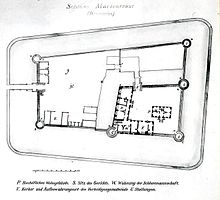Marientraut Castle
| Marientraut Castle | ||
|---|---|---|
|
Drawing of Marientraut Castle, made by Landgrave Moritz von Hessen-Kassel , 1630 |
||
| Creation time : | 1414 | |
| Castle type : | Niederungsburg | |
| Conservation status: | Burgstall, remains of a moat | |
| Place: | Hanhofen | |
| Geographical location | 49 ° 18 '57.2 " N , 8 ° 20' 14.8" E | |
|
|
||
The castle Marie Traut is an Outbound Wasserburg of the diocese of Speyer in Hanhofen in Rhein-Pfalz-Kreis .
Location and building stock
The Niederungsburg was at the western end of the village of Hanhofen, north of today's main street. Preserved remains of the moat show the former location there. The name is derived from a portrait of Mary with which the complex was adorned. The castle had the shape of an unequal square, surrounded by wide moats and a surrounding fortification wall with towers. The northern moat was about 125 meters long, the southern 122 meters, the eastern 112 and the western 90 meters. They were fed by an underground channel from the nearby Woogbach. In the west lay the outer bailey , in the east the additionally secured main castle with the bishopric and official seat.
history
In 1414, the Speyer bishop Raban von Helmstatt had a castle built opposite the monastery mill in Hanhofen, a place belonging to his monastery . It served as a fortified seat to secure his sovereignty. At the same time, due to its favorable location on Speyerbach and Woogbach, the water supply of Speyer could be controlled. This was one of the reasons why troops from the imperial city of Speyer, in league with Duke Stephan von Zweibrücken and Margrave Bernhard I of Baden , stormed the castle in 1417 (according to other sources, 1419), tore down the walls and put the stones on wagons they had brought to repair the City walls to Speyer.
However, Emperor Sigismund confirmed the episcopal rights, so that the castle could be restored from 1422. From 1463 to 1471, it was expanded to an area four times larger , mainly by Bishop Matthias von Rammung , and protected by a tower-filled wall and a moat. He named the castle after St. Maria, the patron saint of his diocese, and had a stone image of Mary attached to it as well as an inscription with the year 1463 and the name.
Since 1475 it served as the seat of settled in Hanhofen Prince Bishops Under Office or his bailiff . This was separated from the Lauterburg Oberamt in 1554 and made a Oberamt itself . Peter IV. Nagel von Dirmstein became the first senior magistrate . At the turn of the 16th and 17th century residence of Johann Christoph dog Saulheim († 1624), the father of the Mainz cathedral dean Adolph dog of Saulheim as bailiff and Vogt to Marie Traut. In 1623, with the completion of the Speyer fortress Philippsburg , Marientraut lost its strategic importance. In 1630, Landgrave Moritz von Hessen-Kassel and his sons visited the facility and made a drawing of it.
Around 1700 the castle was largely destroyed. It is uncertain whether this already happened in the Palatinate War of Succession or not until the Spanish War of Succession . The fact that the French occupied the castle both in 1690 and before the Battle of the Speyerbach (1703) is well known. From the 18th century Marientraut was again only a sub-office and with its villages Hanhofen, Harthausen , Heiligenstein , Dudenhofen , Schifferstadt and Otterstadt belonged to the upper office of Kirrweiler . Possibly this was related to the destruction of the official residence. In 1722, Prince-Bishop Damian Hugo Philipp von Schönborn-Buchheim had the main building rebuilt in the Baroque style. 1792–1794, the invaded French revolutionary troops looted Marientraut and burned her down. After the areas on the left bank of the Rhine were transferred to France, the ruins were auctioned on June 1, 1804 in Mainz as a national property and passed to the citizen Jakob Friedrich Sartorius. He had the remains removed, the surface leveled and the stones sold as building material. The inscription stone of Bishop Matthias von Rammung from 1463 was installed on a house in Schwegenheim and later came to Speyer, to the Palatinate Historical Museum .
literature
- Peter Gärtner: History of the Bavarian-Rhineland Palatinate Castles , Volume 2, p. 388 u. 389, Speyer, 1855
- Michael Frey : Attempt of a geographical-historical-statistical description of the royal Bavarian Rhine district. Part 2, Speyer, 1836, pp. 161-163; (Digital scan)
- Friedrich Johann Hildenbrand: Marientraut Castle near Hanhofen near Speier a. Rh., (1414-1804). In: Local history publications of the Historisches Museum der Pfalz in Speyer. 1922, (find information)
- Matthäus Merian , Martin Zeiller : Marientraut , in: Topographia Palatinatus Rheni , 2nd edition, Matthäus Merians Seel. Erben, Frankfurt am Main, approx. 1672, p. 62; (Digital view)
Web links
- Website about Marientraut Castle
- Newspaper article about Marientraut Castle
- Reconstruction drawing by Wolfgang Braun
Individual evidence
- ↑ Website for the building inscription
- ^ Document from Johann Christoph Hund von Saulheim, as Oberamtmann von Marientraut, 1596 in the German Digital Library
- ^ Website of the University of Kassel about the visit of Landgrave Moritz
- ^ Franz Xaver Remling : Documentary history of the former abbeys and monasteries in what is now Rhine Bavaria , Volume 1, p. 286, Neustadt, 1836; (Digital scan)




